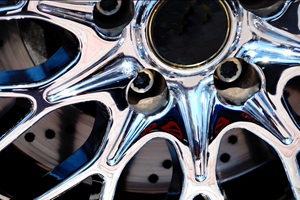Trivalent Chromates Revisited
I normally do not write about recent papers in the technical literature. However, a paper that appeared in the October issue of Plating and Surface Finishing was of great interest and requires wider distribution. The paper, “Unexpected Results from Corrosion Testing of Trivalent Passivates,” by T. Rochester & Z. W. Kennedy, discusses results using one of the standard tests for the presence of hexavalent chromium.
The following appeared in my December column. I received a number of e-mails from readers discussing these results. The original item is reprinted below, followed by a few of the comments I received.
Thanks to everyone who took the time to comment.
I normally do not write about recent papers in the technical literature. However, a paper that appeared in the October issue of Plating and Surface Finishing was of great interest and requires wider distribution. The paper, “Unexpected Results from Corrosion Testing of Trivalent Passivates,” by T. Rochester & Z. W. Kennedy, discusses results using one of the standard tests for the presence of hexavalent chromium.
One of the tried and true testing methods for hexavalent chromium is the use of 1,5-diphenylcarbazide to form a colored complex with hexavalent chromium. The intensity of the color is measured colorimetrically. The colored complex does not form with trivalent chromium. (I personally performed this test many, many times early in my career.)
Why has the test taken on added significance? Everybody should know the answer to this question! The main “drivers” are the End of Life Vehicle Directive (ELV) as well as the Restriction of Hazardous Substances Directive (RoHS) promulgated by the European Union. These directives limit the amount of hexavalent chromium that can be present in or on a component or part. Surprisingly, neither of these directives spells out a procedure for testing for hexavalent chromium in parts.
So much for the background. What did the authors report? Salt spray tests were performed using the standard ASTM B-117 Salt Spray test procedure. The 1,5-diphenylcarbohydroxide test solution was freshly prepared. The test pieces were primarily M10 machine screws and washers. Parts were evaluated after 24 hours in the salt spray chamber. The test results were as follows:
| Test | Test Conditions | Results |
| 1 | Trivalent passivated part with a drop of test solution on surface placed in salt spray chamber in a horizontal position for 24 hr. | Drop of test solution turned reddish brown |
| 2 | Same test as 1 but part is not passivated. | Drop of test solution did not turn reddish brown |
| 3 | Trivalent passivated part placed above a crystallizing dish and introduced into the salt spray chamber. The condensate after 24 hr was diluted and tested with the test solution. | Solution turned red-violet, indicating the presence of hexavalent chromium. |
| 4 | Same test as 3, but part was not passivated. | No color development observed. |
What do these test results mean? They seem to indicate that trivalent chromium can be oxidized to hexavalent chromium in the salt spray chamber. The implication is that parts that are free of hexavalent chromium when they leave the plating shop may later test positive and be rejected.
The authors postulate on a possible mechanism for this behavior. Readers of this column need not worry as to what the possible mechanism might be (at least not at this moment), but they should be aware that the dash to trivalent chromium passivation may not be as simple as initially thought. Another case of “unintended consequences?”
This may also explain some of the anomalous behavior that some vendors of trivalent chromium passivation products have experienced.
For those readers who are members of the National Association of Metal Finishers (NASF) pick up your copy of the October issue of Plating & Surface Finishing and read the article. I’m sure we are going to have a lot more discussion on this subject in the next few months.
Some Reader Comments:
“...the results should not be that shocking, since the environment we live and breath in everyday is quite simply a massive redox reaction. One so massive the limits and interactions of everything in it produce limitless variables.”
“I plan on repeating the tests here to see what the tri-chrome conversion coatings are doing.”
“It’s not surprising to me, and in fact I always suspected hex chrome was forming to make tri-chrome look so good in salt spray testing.”
Related Content
An Overview of Electroless Nickel Plating
By definition, electroless plating is metal deposition by a controlled chemical reaction.
Read MoreInnovation in Plating on Plastic
Plating on advanced plastics solution offers improved adhesion, temperature resistance and cost savings.
Read MoreA Chromium Plating Overview
An overview of decorative and hard chromium electroplating processes.
Read MoreProducts Finishing Reveals 2024 Qualifying Top Shops
PF reveals the qualifying shops in its annual Top Shops Benchmarking Survey — a program designed to offer shops insights into their overall performance in the industry.
Read MoreRead Next
A ‘Clean’ Agenda Offers Unique Presentations in Chicago
The 2024 Parts Cleaning Conference, co-located with the International Manufacturing Technology Show, includes presentations by several speakers who are new to the conference and topics that have not been covered in past editions of this event.
Read MoreEpisode 45: An Interview with Chandler Mancuso, MacDermid Envio Solutions
Chandler Mancuso, technical director with MacDermid Envio discusses updating your wastewater treatment system and implementing materials recycling solutions to increase efficiencies, control costs and reduce environmental impact.
Read MoreDelivering Increased Benefits to Greenhouse Films
Baystar's Borstar technology is helping customers deliver better, more reliable production methods to greenhouse agriculture.
Read More


























